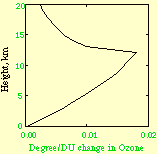 |
Stratospheric Processes And their Role in Climate
|
||||||||
| Home | Initiatives | Organisation | Publications | Meetings | Acronyms and Abbreviations | Useful Links |
![]()
 |
Stratospheric Processes And their Role in Climate
|
||||||||
| Home | Initiatives | Organisation | Publications | Meetings | Acronyms and Abbreviations | Useful Links |
![]()
Stratospheric ozone is an important radiatif gas and decreases in stratospheric ozone have been shown to have a significant effect on the global radiative budget, acting to cool the earth's surface, and counteracting the warming due to increases in greenhouse gases. Ozone reduction also induces a local cooling in the stratosphere.
This working group has two goals:
1 - To improve the understanding of ozone trends in the stratosphere and to consider the methods of analysis and determination of these trends
2 - To review the quality of ozone measurements that will be made in the coming years, and to contribute to the development of a measurement validation programme.
More information on the activities and action plan of this initiative as for 1999 is available in the SPARC Implementation Plan.

Expected change in temperature at the earth's surface per Dobson unit of ozone change in the atmosphere at various altitudes (adopted from the work of Lacis et al.). (Figure 3.3 of the SPARC Implementation Plan)
Together with the International Ozone Commission (IOC) and the WMO Global Atmospheric Watch (GAW), this working group has produced an assessment of measurements of trends on the vertical distribution of ozone. The work carried out by this group was of great help for the WMO/UNEP 1998 Ozone Assessment.
Access to the SPARC/IOC/GAW Assessment of Trends in the Vertical
Distribution of Ozone
(to receive a copy, please contact the SPARC Office)

Estimate of the mean trend in the vertical distribution of ozone that has occurred over northern mid-latitudes from 1980-1996 (heavy solid line) calculated using the trends derived from SAGE I/II, ozonesondes, SBUV and Umkehr measurements. Combined uncertainties are shown as 1s (light solid lines) and 2s (dashed lines). The combined trends and uncertainties are extended down to 10 km as shown by the light dotted lines. The results below 15 km are a mixture of stratospheric and tropospheric trends and the exact numbers should be viewed with caution. Combined trends have not been extended lower into the troposphere because there are concerns regarding the representativeness of any mean trends derived from the small sample of sonde stations. (Figure from the SPARC/IOC/GAW Assessment of trends in the vertical distribution of ozone)
Review of space-based observations of atmospheric chemistry,
J. Kaye, SPARC Newsletter 8, January 1997.
SPARC Report N°1 : SPARC/IOC/GAW Assessment of Trends in the Vertical Distribution
of Ozone
N. Harris and R. Hudson, 1998.(to receive a copy, please contact
the SPARC Office)
Summary of the SPARC-IOC Assessment,
N. Harris and R. Hudson, SPARC Newsletter 10, January 1998.
BUV O3 data: Calibration/Validation for Trends,
E. Hilsenrath et al., SPARC Newsletter 10, January 1998.
International O3 Scientific Assessment,
D. Albritton, SPARC Newsletter 11, July 1998.
Impact of Stratospheric Ozone Changes on Tropospheric Species,
C. Granier, SPARC Newsletter 13, July 1999.
WMO/UNEP Scientific Assessment of Ozone Depletion, 1994 and 1998.
European Ozone Research Coordination Unit Home Page
![]()
Last update: March 20, 2001